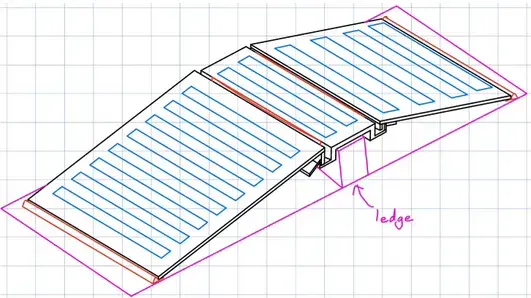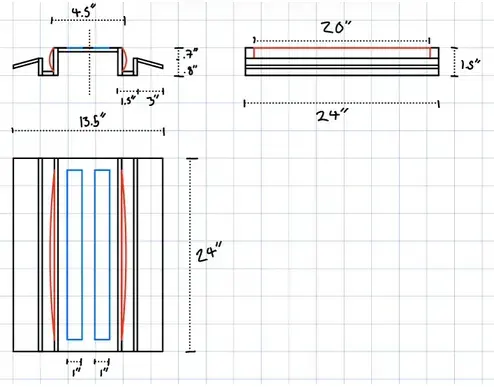Hey goobers! This post will be about my final project for the 2nd quarter of a 2 quarter sequence at Northwestern known as Design Thinking and Communciation (DTC). Here’s my final project for the first quarter of the sequence: Nesting Number Blocks.
My group members (Zora Hinrichs, Felix Jacobs, Rachel Soares), and I designed Safesplash, a shower ramp tailored to help adults with intellectual and developmental disabilities enter and exit showers at Misericordia Home. This was prepared for Trina Semelroth, a caretaker at Misericordia, who now uses our product in their homes.
Table of Contents
Open Table of Contents
- Final Poster
- Executive Summary
- Introduction
- Design Concept and Rationale
- Accomplishment!
- References
- Appendices
- Appendix A: Research Background
- Appendix B: Project Definition
- Appendix C: Project Purchasing Record Bill of Materials
- Appendix D: Observations Summary
- Appendix E: Project Partner Interview Summary
- Appendix F: Mockup Testing and Feedback Summary
- Appendix G: Design Freeze
- Appendix H: Instructions for Construction
- Appendix I: Instructions for Use
Final Poster
For those who don’t wanna read this monster post, I don’t blame you:
Executive Summary
Individuals with intellectual disabilities require shower devices that are tailored to their needs, ensuring safety, accessibility, and dignity. However, existing products often need more features to meet their need for accessing and exiting the shower area safely. Due to this issue, Misericordia Home, a non-profit organization in Chicago, IL, needs help providing individuals with quality devices. Not to mention that the frequency of bathroom-related injuries, particularly slips and falls during shower use, underscores the importance of preventive measures for currently underutilized accidents. Enhancing bathroom safety through appropriate design and equipment adjustments is crucial to reduce accidents and promote independence among individuals with disabilities. The project aims to design the SafeSplash showering system, a device to aid adults with various disabilities in safely and comfortably entering/exiting shower areas. The primary priorities for this design include accessibility, ease of use, universality, and safety. Accessibility entails supporting individuals in navigating bathroom environments safely, and promoting independence while maintaining dignity. Ease of use ensures the device is compact, easy to set up, and transportable, accommodating weights up to 400 lbs. Universality focuses on adapting to different shower ledge heights and ensuring versatility across various environments. Safety incorporates water-resistant, non-slip properties to ensure reliable assistance during transfers. The SafeSplash system features three interlocking pieces forming a two-sided ramp, with a secure ramp holder attached to the shower ledge. This design facilitates safe access using a wheeled mechanism or by walking up non-slip ramps. The components are lightweight, adjustable, and engineered to meet safety and accessibility standards. Potential enhancements include experimenting with different materials, refining rubber edges for better fit, minimizing gaps, and improving load-bearing capacities. Further testing and development will focus on optimizing the design for structural integrity and ease of use. In conclusion, the SafeSplash device meets all product requirements and addresses the specific needs of Misericordia residents. By prioritizing inclusivity, safety, and ease of use, the design empowers individuals with intellectual disabilities to access shower facilities comfortably and independently. Its adaptability to various shower conditions and environments ensures that it can significantly enhance the daily hygiene routines of adults at Misericordia, fostering a sense of dignity and autonomy.
Introduction
Intellectual disability, which affects approximately 6.5 million individuals in the United States [1], encompasses a range of challenges in cognitive functioning, communication, and social skills [2]. These difficulties significantly impact daily activities, including personal hygiene routines such as showering [3]. Unlike individuals without intellectual disabilities, those with intellectual disabilities often struggle with processing and understanding instructions, making it harder to follow complex sequences of steps involved in showering. Additionally, sensory sensitivities or difficulties with motor coordination can further impede their ability to navigate the physical space of a shower room safely [4]. As a result, adults with intellectual disabilities may require more assistance and support in accessing and using shower facilities, exacerbating the challenges they face in maintaining personal hygiene (Appendix A: Research Background).
Ensuring the safety and well-being of adults with intellectual disabilities in shower areas requires careful attention to design and equipment. Statistics reveal the alarming frequency of bathroom-related injuries, with slips and falls during shower or tub use being a leading cause [5]. Despite this, preventive measures like grab bars and non-slip mats are underutilized [6]. Implementing such measures, along with adjusting shower and toilet heights and providing education on safety practices, can greatly reduce the risk of accidents, promoting safety and independence for all users [7].
This need for enhanced safety measures is exemplified by the difficulties encountered by Misericordia Home, a non-profit organization based in Chicago, Illinois [8]. Many of their older bathrooms are ill-equipped to meet the needs of individuals with physical and developmental disabilities. Specifically, the diameter of the wheelchair is not sufficient to overcome the height of the shower ledge. (Appendix B: Project Definition).
Trina Semelorth, an occupational therapist at Misericordia Home, outlined the typical procedure for transferring residents to the shower. This process involves a caretaker assisting residents using a belt grip and metal bar handles for support. If standing is challenging, residents are placed onto a roller chair, usually a shower chair, and wheeled backward into the shower. However, some residents prefer to face forward when entering the washroom. Currently, there is no inner ramp in place. As a result, the shower chair must be lifted from outside the shower by the caretaker, which poses a risk to both the resident and the caretaker handling the object. Residents have articulated a preference for seamless entry and exit without abrupt ledge drops during this process (Appendix D: Observation Summary).
The project aims to design a device tailored to adults with various disabilities that aids them in safely and comfortably entering/exiting the shower area while ensuring ease for caretakers. After consolidating all project requirements and design needs, the primary priorities entail accessibility, ease of use, universality, and safety. It is crucial to maintain compactness and adhere to ADA guidelines while addressing these priorities.
- Accessibility: The item must support individuals with intellectual disabilities in accessing and exiting shower facilities while offering assistance tailored to their specific needs. This may include providing support to navigate the bathroom environment, ensuring safety, and promoting independence while maintaining dignity.
- Ease of Use The device must prioritize ease of use for the caretaker. It should be compact, with a length that doesn’t crowd the bathroom, ensuring unimpeded access for other residents. It should weigh no more than 50 lbs (ideally targeting 30 lbs) while supporting over 400 lbs to accommodate both the resident, their wheelchair, and the caretaker. Additionally, it should be easily transported and convenient.
- Universality The design must be universally adaptable, and suitable for different shower ledge heights, primarily targeting 2-3 inches. It should securely fit onto ledges with a width of 4 inches, ensuring versatility across various shower environments.
- Safety The device must be meticulously engineered to support the weight of both the resident and the caretaker, ensuring reliable assistance during transfers. Additionally, it should feature water-resistant and non-slip properties to enhance safety for both those in need of assistance and those providing it. Not to mention, that the ramp part of the design must follow the ADA rules: it must be 1:8. [9]
In the rest of this post, the design concept and rationale, future developments of the project, and conclusions from the project will be discussed.
Design Concept and Rationale
Overview
Overview The SafeSplash showering system is an accessible, multifaceted solution designed to assist residents of Misericordia in safely and easily entering showers with ledges over two inches high. This innovative design comprises three interlocking pieces that form a two-sided ramp. The primary component, the “ramp holder,” securely attaches to the top of the shower ledge. To set up the system, either a resident or a caretaker can effortlessly place the ramps— a longer one for outside the shower and a shorter one for inside—into designated slots that align perfectly with the ramp edges. This allows for safe and easy access using either a wheeled mechanism or by walking up the non-slip ramps. For detailed usage instructions (Appendix I: Instructions of Use), please refer to the steps below:
- Place the ramp holder on top of the ledge in the bath ledge.
- Once in place, add the longer ramp to the outside so that the rubber piece touches the floor outside the bathtub. Then add the smaller ramp to the inside of the shower so that it attaches itself to the ramp holder. Ensure that the connecting pieces are in place next to the rubber to prevent the system from sliding around.
- Then, push the resident in a shower chair or other wheeled system up the outer ramp, down the inner ramp, and into the shower safely.
It’s crucial to emphasize that neither the resident nor the caretaker should remove the ramp during the resident’s shower, as the device was designed to provide sufficient space for comfortable showering within the shower area.
This sketch shows the assembled system of SafeSplash

Component Breakdown

The ramp holder attaches to the ledge that blocks access to the shower. It has two divots where inserts attached to each ramp can easily enter and stay in place. This customizable attachment allows for easy changes depending on the height of the ledge entering the shower.
Rationale:
- Crafting a removable piece enables caretakers to effortlessly relocate each segment after the resident’s shower, sparing them from the burden of handling a bulky ensemble. This becomes notably lighter when removing each piece individually compared to lifting the entire system with all three pieces intact.
- The adaptable attachment provides seamless adjustments tailored to varying heights of the shower entry ledge, ensuring optimal usability and accessibility for all residents.
The inner ramp goes inside the shower and the outer ramp is locked from the ramp holder to the floor outside the shower.
Inner Ramp (top) and Outer Ramp (bottom)


Future Development
The “SafeSplash” device facilitates safer and easier access to the shower for adults with intellectual disabilities and their caretakers. For further project development, we could consider implementing the following changes and conducting additional user testing:
- Exploring alternative materials for the ramp holder beyond coated medium-density fiberboard to mitigate waterproofing concerns and prevent environmental degradation. For instance, conducting experiments with materials like corrosion-resistant metals or durable plastics could offer enhanced longevity without compromising structural integrity or waterproofing. (Fulfills the safety requirement)
- Conducting extensive research and experimentation to optimize the design of rubber edges on the bottom edge of the ramp holder, aiming for precise thickness alignment with the ramps. This iterative process involves testing various types of rubber and adjusting their dimensions to achieve the closest possible match to the ramp thickness, thus ensuring stability and safety during use. (Fulfills the accessibility and ease of use requirement)
- Investigating advanced height adjustment mechanisms for the ramps beyond relying solely on rubber edging. Exploring options such as telescopic or screw-based adjustments could provide more precise control over ramp height, catering to individual user needs and ensuring optimal accessibility. (Fulfills the universality requirement)
- Refining the design of the ramp inserts to the side of the ramp holder for a snug fit, minimizing gaps between the ramp and the ledge. Utilizing advanced manufacturing techniques like precision molding or CNC machining can help achieve tighter tolerances, enhancing the overall stability and safety of the system. (Fulfills the universality and the ease of use requirement)
- Exploring lightweight yet robust materials that offer comparable strength to medium-density fiberboard and wood for the ramp system. Materials like high-strength composites or advanced polymers can provide the necessary load-bearing capacity while reducing the strain on caretakers during system movement or unloading. (Fulfills the ease of use requirement)
- Investigating additive manufacturing techniques such as 3D printing to create customizable materials that mold around the ledge height and compress when ramps are pressed onto it. By leveraging materials with adaptive properties, structural integrity can be maintained while ensuring a tailored fit to varying ledge heights. Fulfills the universality requirement)
- Conducting rigorous load testing to determine the system’s limits and identify potential weaknesses in structural components. Establishing clear load-bearing thresholds through comprehensive testing protocols ensures resident safety and allows for appropriate warnings or precautions to be implemented. (Fulfills the safety requirement)
Accomplishment!
Safesplash meets all of the product requirements set before the design stage and the key needs of the Misericordia residents. In terms of accessibility, the design prioritizes inclusivity by incorporating universality. The ramp-holder can be easily transported and moved to each shower. Further, the ramps accommodate any shower ledge height that it encounters. By merging universality with safety and accessibility, our design can work in any condition. For safety, all materials involved work extremely well in the shower setting (non-slip and waterproof). For instance, the medium-density fiberboard used in the ramp components is covered in a flex seal that protects against corrosion in repeated contact with water and is non-toxic. Safety is necessary to ensure, and the medium-density fiberboard went through extreme testing and even has more wooden supports underneath that ensure it can hold the resident in a wheelchair and even an assisting caretaker. In terms of ease of use, SafeSplash is easy to set up and remove. Capable residents and all caretakers can manage the relatively lightweight design and adjustable components that allow them to quickly set down the ramp-holder and two ramp components and enter the shower. Concerning universality, by adding a flexible rubber seal to the bottom of the medium-density fiberboard, the external and internal shower ramps can easily be adjusted to overcome external ledge heights between 2-3 inches and internal ledge heights of 1-1.75 inches.
Overall, Safesplash not only fulfills the product requirements and addresses the specific needs of Misericordia residents but also underscores its commitment to empowering individuals with intellectual disabilities. By prioritizing inclusivity and accessibility in its design, SafeSplash ensures that individuals of all abilities can access shower facilities comfortably and safely. Its universality allows it to adapt to various shower conditions, making it suitable for diverse environments. Moreover, the emphasis on safety, ease of use, and versatility highlights its potential to significantly enhance the shower routines of adults at Misericordia, ultimately empowering them to enjoy a sense of independence and dignity in their daily lives.
References
[1] CDC. Health Care for Individuals with Intellectual Disabilities. Centers for Disease Control and Prevention. Available at: https://www.cdc.gov/grand-rounds/pp/2019/20191015-intellectual-disabilities.html
[2] “About Intellectual and Developmental Disabilities (IDDs) | NICHD - Eunice Kennedy Shriver National Institute of Child Health and Human Development.” Accessed: Oct. 03, 2023. [Online]. Available: https://www.nichd.nih.gov/health/topics/idds/conditioninfo
[3] Learning for a Purpose. Sensory Issues with Showering: Solutions and Strategies. Available at: https://learningforapurpose.com/tips-to-improve-showering-and-bathing-for-children-with-sensory-processing-difficulties/
[4] “Caregiving: How to Help With a Shower Behavioral Health & Intellectual disability”. Services - Philadelphia, Pennsylvania. Available at: https://philadelphia.pa.networkofcare.org/mh/library/article.aspx?hwid=abq1244
[5] “CPSC Releases New Study on Bathtub and Shower Injuries”. Consumer Product Safety Commission. Available at: https://www.cpsc.gov/New-Study-On-Bathtub/Shower-Injuries
[6] “Challenges of Impaired Mobility in the Bathroom and Ways to Overcome Them” CareServe. Available at: https://www.essentialaids.com/challenges-impaired-mobility-bathroom
[7] “Safety Stats for Your Bathroom”. Thompson Creek. Available at: https://www.thompsoncreek.com/blog/safety-stats-for-your-bathroom
[8] “About Us | Misericordia,” . Misericordia Home. Available at: https://www.misericordia.com/about/
[9] U.S. Access Board. U.S. Access Board - ADA Accessibility Standards. Available at: https://www.access-board.gov/ada/